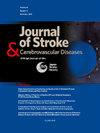Safety and efficacy of argatroban combined with antiplatelet therapy for acute mild-to-moderate ischemic stroke with large artery atherosclerosis
IF 2
4区 医学
Q3 NEUROSCIENCES
Journal of Stroke & Cerebrovascular Diseases
Pub Date : 2024-11-27
DOI:10.1016/j.jstrokecerebrovasdis.2024.108151
引用次数: 0
Abstract
Background and Purpose
Patients with stroke due to large artery atherosclerosis are at risk of early progression and recurrence. The efficacy and safety of argatroban in stroke patients who did not receive reperfusion therapy, and which patients may benefit from it, are uncertain.
Methods
We conducted a cohort study to assess whether argatroban given within 72 hours of symptom onset, combined with antiplatelet therapy, improved neurological outcomes of patients with acute mild to moderate ischemic stroke in China. Patients were divided into the combined treatment group and the control group. Inverse probability of treatment weighting was used to balance baseline covariates. The primary efficacy outcome is the proportion of mRS score 0-2 at 90 days. The secondary efficacy outcomes included END proportion, change in NIHSS score from the baseline to day 7, recurrent cardiovascular events, and cardiovascular death. The safety outcomes were hemorrhagic transformation (HT) of infarction and organ hemorrhage at 7 days.
Results
Compared with the control group, a higher proportion of mRS (0-2) at 90 days was found in patients in the combined treatment group (85.3% vs 74.5%, p=0.042). There was no significant difference in the safety outcomes between the two groups. Exploratory subgroup analysis showed positive associations with argatroban combined therapy and good prognosis in NIHSS score ≥5 and age ≥70 subgroups.
Conclusions
Our study suggested that argatroban can improve neurological outcomes for mild to moderate LAA patients but not increase the risk of bleeding.
阿加曲班联合抗血小板治疗急性轻中度缺血性脑卒中合并大动脉粥样硬化的安全性和有效性
背景与目的:大动脉粥样硬化所致脑卒中患者存在早期进展和复发的风险。阿加曲班在未接受再灌注治疗的脑卒中患者中的疗效和安全性,以及哪些患者可能从中受益,尚不确定。方法:我们进行了一项队列研究,以评估在症状出现72小时内给予阿加曲班并联合抗血小板治疗是否能改善中国急性轻中度缺血性脑卒中患者的神经系统预后。患者分为联合治疗组和对照组。使用治疗加权逆概率来平衡基线协变量。主要疗效指标为90天mRS评分0-2的比例。次要疗效指标包括END比例、NIHSS评分从基线到第7天的变化、心血管事件复发和心血管死亡。安全性指标为7天梗死的出血性转化(HT)和器官出血。结果:与对照组相比,联合治疗组患者90天mRS(0-2)比例更高(85.3% vs 74.5%, p=0.042)。两组之间的安全性结果无显著差异。探索性亚组分析显示,在NIHSS评分≥5分、年龄≥70岁的亚组中,阿加曲班联合治疗与预后良好呈正相关。结论:我们的研究表明,阿加曲班可以改善轻中度LAA患者的神经预后,但不会增加出血的风险。
本文章由计算机程序翻译,如有差异,请以英文原文为准。
求助全文
约1分钟内获得全文
求助全文
来源期刊

Journal of Stroke & Cerebrovascular Diseases
Medicine-Surgery
CiteScore
5.00
自引率
4.00%
发文量
583
审稿时长
62 days
期刊介绍:
The Journal of Stroke & Cerebrovascular Diseases publishes original papers on basic and clinical science related to the fields of stroke and cerebrovascular diseases. The Journal also features review articles, controversies, methods and technical notes, selected case reports and other original articles of special nature. Its editorial mission is to focus on prevention and repair of cerebrovascular disease. Clinical papers emphasize medical and surgical aspects of stroke, clinical trials and design, epidemiology, stroke care delivery systems and outcomes, imaging sciences and rehabilitation of stroke. The Journal will be of special interest to specialists involved in caring for patients with cerebrovascular disease, including neurologists, neurosurgeons and cardiologists.
 求助内容:
求助内容: 应助结果提醒方式:
应助结果提醒方式:


